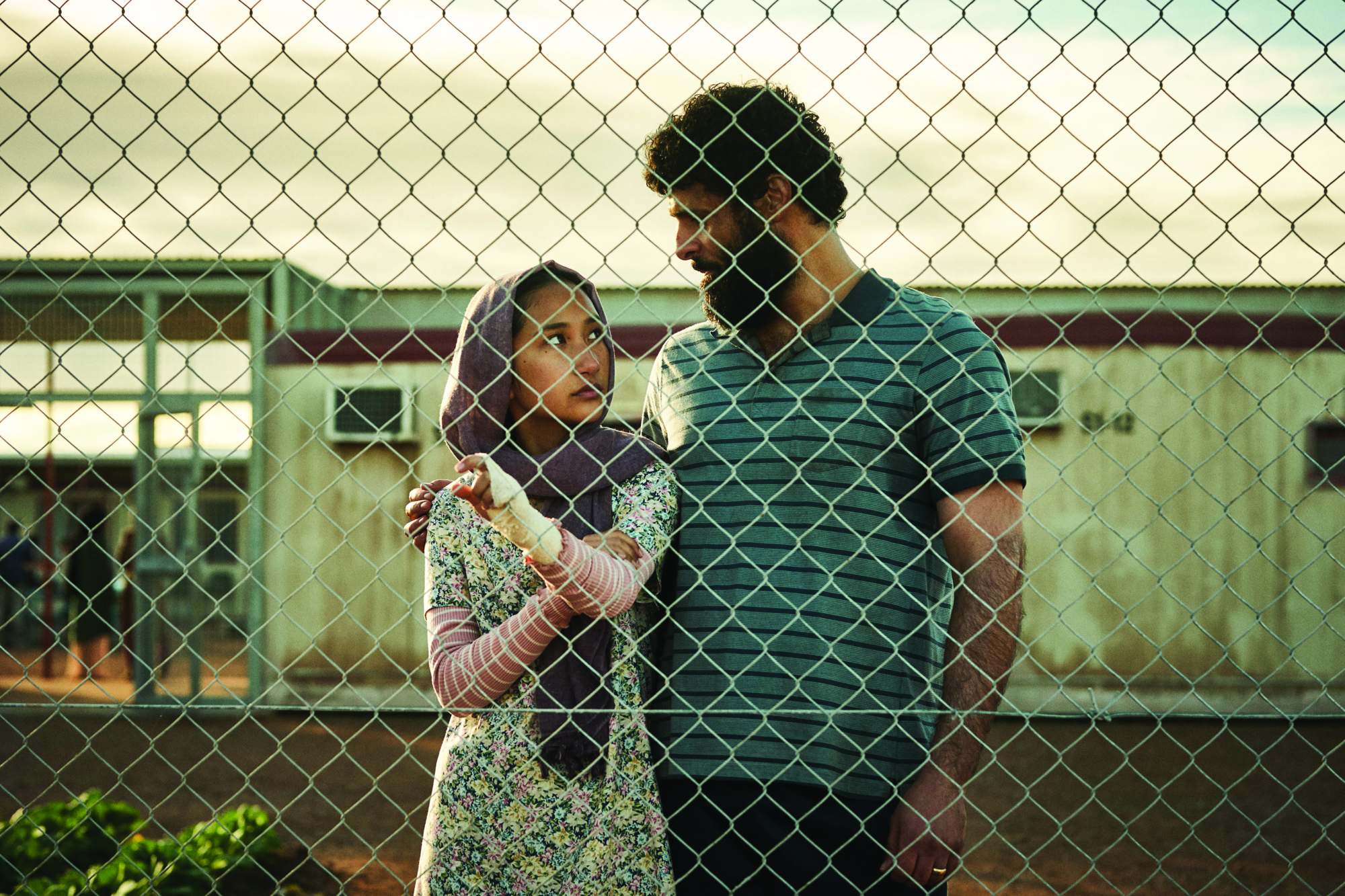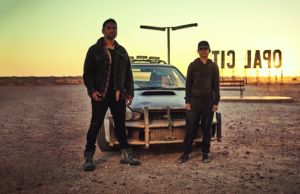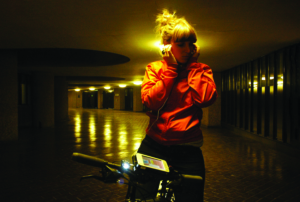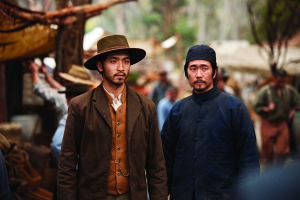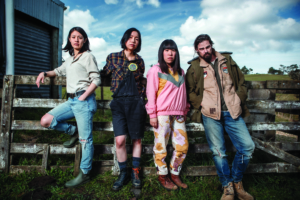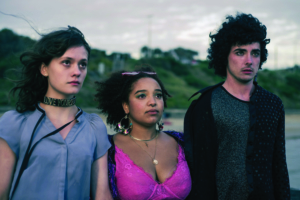The night of 30 November 2020 should have been one of unadulterated celebration for Elise McCredie, co-creator of miniseries Stateless. Her show had just picked up an impressive thirteen AACTA Awards, including Best Telefeature or Mini Series and all four television-drama acting awards. But her comments in an ABC News article the day after betray more than a hint of defensiveness:
We wouldn’t have been able to get [the series] financed, unfortunately, unless we had white stars […] As a creator and someone who felt passionately that this story needed to be told, I would have preferred to focus entirely on refugee stories.[1]Elise McCredie, quoted in Dee Jefferson, ‘Stateless Sweeps AACTA Awards for TV, While Babyteeth Dominates Film Categories’, ABC News, updated 1 December 2020, <https://www.abc.net.au/news/2020-11-30/babyteeth-wins-best-film-and-many-other-aacta-awards/12934018>, accessed 17 February 2021.
That defensiveness stems from sustained criticism of the show’s choice to foreground white faces in its refugee-drama narrative. A Los Angeles Times interview with co-creator Cate Blanchett was titled ‘A New Netflix[2]Though produced in Australia by the ABC, launching on 1 March 2020, the series later debuted on Netflix in the United States on 8 July that year. Show About Australia’s Refugee Crisis Has a White Heroine. We Asked Why’,[3]Meredith Blake, ‘A New Netflix Show About Australia’s Refugee Crisis Has a White Heroine. We Asked Why’, Los Angeles Times, 8 July 2020, <https://www.latimes.com/entertainment-arts/tv/story/2020-07-08/stateless-cate-blanchett-human-drama-not-agitprop>, accessed 17 February 2021. while a Rolling Stone review decried the show’s emphasis on its white characters: ‘Instead of elevating these immigrant stories, the show diminishes them, by heaping attention on Sofie [played by Polish-Australian actress Yvonne Strahovski], as well as the white bureaucrats and guards who work at the detention center.’[4]Maria Fontoura, ‘Stateless: Detention Camp Drama Floats Adrift’, Rolling Stone, 13 July 2020, <https://www.rollingstone.com/tv/tv-reviews/stateless-netflix-review-1025670/>, accessed 17 February 2021. These are not isolated critiques, and much of the conversation around Stateless – before and after the AACTAs – has centred on the disconnect between its refugee-centric storytelling and the overwhelming whiteness of its cast.
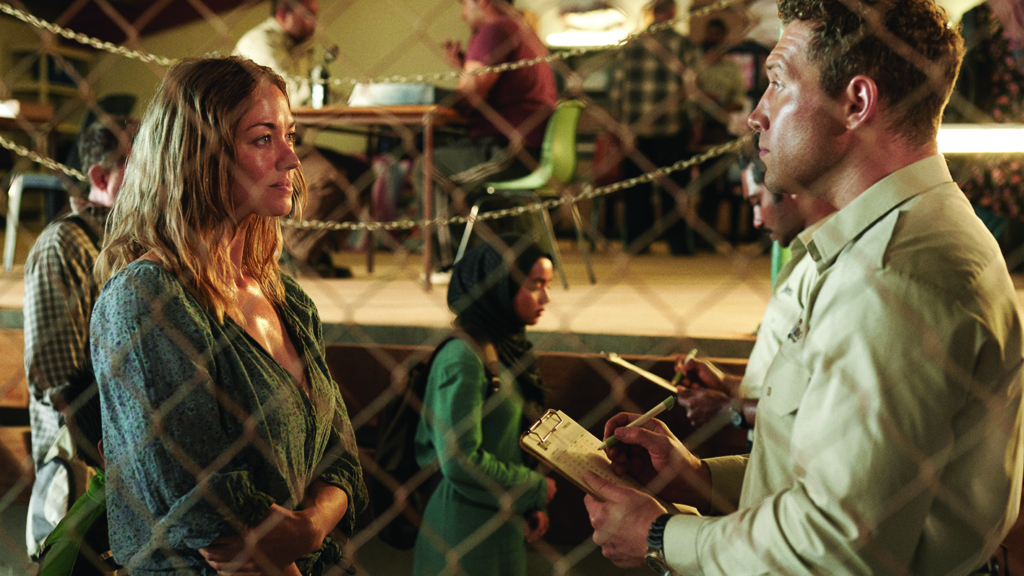
I don’t think that it’s fair to condemn Stateless on these grounds. In the aforementioned ABC News article, McCredie notes that the miniseries ‘took five years to get financed – and that was with Yvonne and Cate’.[5]McCredie, quoted in Jefferson, op. cit. It is fair to examine an entertainment industry in which financing shies away from people of colour, particularly when the end credits of Stateless proudly trumpet that principal production funding came from the government institution Screen Australia.
That said, it’s also fair to critique Stateless for its inability to centre its refugee characters; at every turn, this is a series that prioritises white faces and white feelings. That’s presumably not what show creators McCredie, Blanchett and Tony Ayres were going for when they set out to produce the series. Their stated intent can be summed up in two words: ‘Trojan horse’, a phrase that recurs in interviews with the cast and crew. As McCredie puts it:
We had to make that choice: Do we do this Trojan horse version where we get it made by having these stars? And if you watch the show, you’ll see that Yvonne’s character gets smaller and other characters get bigger, and that was quite deliberate.[6]ibid.
Fayssal Bazzi, who plays Afghan refugee Ameer in the show, offers a similar account:
Hopefully our story can be a stepping stone for the next one – that is just about people of colour and just about [refugee] plights instead of having to use the Trojan horse theory to get people in.[7]Fayssal Bazzi, quoted in Jefferson, ibid.
The ‘Trojan horse theory’ centres on Strahovski’s character, Sofie – a character based on the real-life case of Cornelia Rau, who was imprisoned in an Australian detention centre despite being an Australian citizen.[8]See Daniel Keane, ‘Cornelia Rau, Australia’s Immigration Wars and the True Story Behind TV Drama Stateless’, ABC News,1 March 2020, <https://www.abc.net.au/news/2020-03-01/cornelia-rau-and-the-story-behind-stateless/12001280>, accessed 17 February 2021. As Strahovski herself has said, ‘I think there’s something to be said for the fact that a lot of people need that Trojan horse to be the white Australian woman for the rest of the stories to be relatable.’[9]Yvonne Strahovski, quoted in Perri Nemiroff, ‘Yvonne Strahovski Addresses the Predominately [sic] White Main Ensemble in Stateless’, Collider, 28 July 2020, <https://collider.com/yvonne-strahovski-interview-stateless-chuck/>, accessed 17 February 2021.
It’s fair to critique Stateless for its inability to centre its refugee characters; at every turn, this is a series that prioritises white faces and white feelings.
As an approach to storytelling, this makes a lot of sense. As McCredie acknowledged in another ABC News interview, it’s a tactic inspired by US prison-set TV series Orange Is the New Black.[10]‘New ABC and Netflix Series Stateless Is a Show About Refugees, So Why Is the Cast So White?’, ABC News, updated 11 March 2020, <https://www.abc.net.au/news/2020-02-28/iview-stateless-detention-cate-blanchett-yvonne-strahovski/12005918>, accessed 17 February 2021. An adaptation of the memoir of a white, middle-class woman (Piper Kerman, renamed Piper Chapman for the series and portrayed by Taylor Schilling), the latter series used the hook of a conventionally attractive protagonist relatable to white audiences to gradually shift focus towards stories of working-class women of colour.
There’s no reason that the same approach – which paid dividends for Orange Is the New Black – couldn’t have succeeded here. After all, Rau’s plight drew attention to the injustice facing refugees in Australian immigration detention centres thanks in large part to her whiteness; one of her lawyers, George Newhouse, characterised his client as – here’s that phrase again – the ‘trojan horse which exposed the cruelty and inhumanity of the immigration detention system’.[11]George Newhouse, quoted in Keane, op. cit. Leveraging a fictionalised version of Rau’s story in much the same fashion with an internationally recognised Australian star in the role just makes sense.
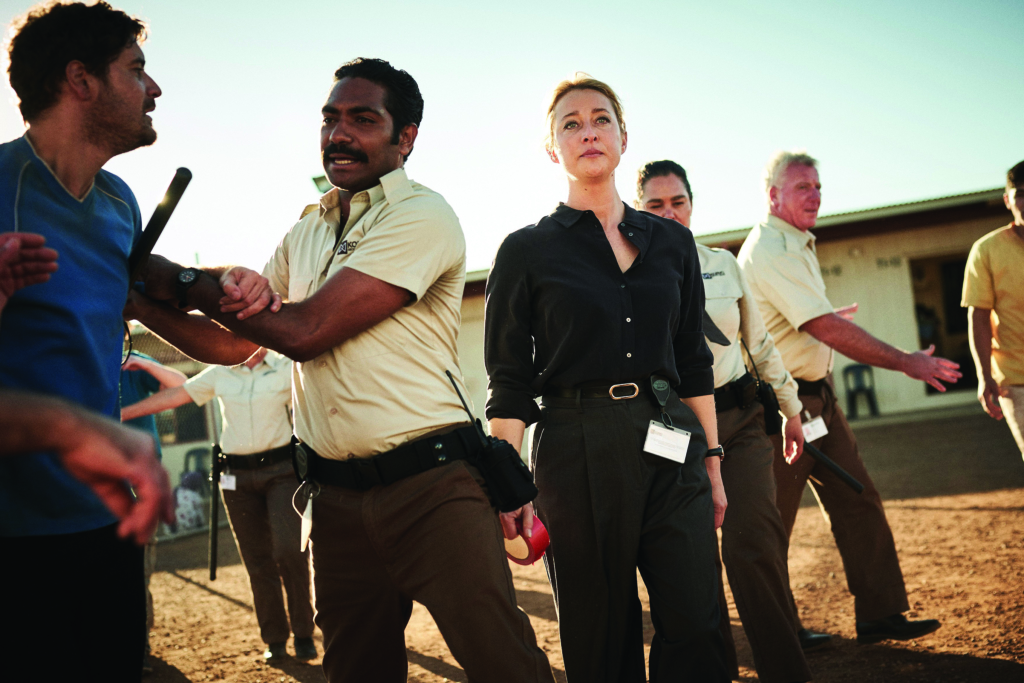
The execution, however, falls short. Stateless’ Trojan horse suffers from shoddy craftsmanship. I’m not referring to the miniseries’ formal qualities; Emma Freeman and Jocelyn Moorhouse’s direction is handsome, and the acting – for the most part – warrants the AACTAs clean sweep. But the ruse employed here isn’t a convincing one.
The length of the miniseries is a factor. A show like Orange Is the New Black – which ran for ninety-one episodes – has the narrative scope to simultaneously craft a compelling story for its protagonist while developing and sustaining a whole host of parallel narratives as the focus gradually shifts away from her. Stateless, spanning only six episodes, lacks the same luxury. But that’s compounded by the fact that Sofie’s narrative, as realised within the series, simply isn’t compelling enough to anchor the show.
This is surprising – Rau’s story is dynamite stuff, after all, custom made for shocking headlines: an Australian citizen, trapped within an immigration centre for months! A tawdry backstory of cults, abuse and mental illness! Yet Stateless struggles to convincingly translate the scandal to the screen in an engaging fashion.
Strahovski commits wholeheartedly to the role – from mania to despair and everything in between, along with an (intentionally?) atrocious attempt at a German accent – but is stymied by the fundamental irrationality of Sofie’s behaviour. Like her real-life inspiration, Rau – who spent months in and out of mental institutions with chronic schizophrenia[12]See Robert Manne, ‘The Unknown Story of Cornelia Rau’, The Monthly, September 2005, <https://www.themonthly.com.au/monthly-essays-robert-manne-unknown-story-cornelia-rau-often-she-cried-sometimes-she-screamed-she-be#>, accessed 17 February 2021. – Sofie suffers from a serious mental illness, exacerbated by her exposure to a cult (run by Blanchett and Dominic West’s characters, each doing their best to devour a whole set’s worth of scenery in the process). True to life, perhaps, but hardly inviting, particularly when her storyline is obscured by a non-linear narrative revolving around unrevealing flashbacks. Characters like Piper Chapman succeed as windows into another world not (just) because they’re white, but because their storyline is relatable to middle-class audiences; Strahovski might look relatable to a middle-class white Australia, but Sofie’s storyline is anything but.
The centring of Clare elucidates the creators’ inability to truly imagine the plight of a refugee. The latter’s suffering, it seems, is only important in how it makes ‘us’ feel sad.
That’s arguable, of course; Sofie’s story might resonate with your own experience, or that of a friend or family member. This reveals a significant problem with the Trojan horse theory. Even when rendered comparatively successfully, it relies on sweeping assumptions about the background, interests and even ethnicity of the audience. Stateless is built around the belief that its viewers are primarily interested in white-centric storylines, and its decisions – and the majority of its missteps – flow from there. It’s fine to challenge audience expectations, but the Trojan horse approach is so inherently ungenerous – particularly in the context of a show pitched at (largely left-leaning, middle-class) ABC viewers – that it unbalances everything.
That’s clear when you compare Sofie with Ameer. He’s one of the three protagonists introduced in Stateless’ first episode, alongside Sofie and incoming immigration centre security guard Cam (Jai Courtney). While Ameer might not be white – which apparently presents a problem for the intended audience – his story, framed correctly, is infinitely more compelling than Sofie’s. It’s the story of most refugees: a desperation to escape oppression and to protect one’s family. But Stateless’ screenwriters seem convinced we won’t be able to relate to Ameer, so he’s relegated to third fiddle behind Sofie and Cam.
This all ties into another major structural problem with Stateless’ Trojan horse. An ‘effective’ Trojan horse should entice us, lull us into letting our guard down before we’re suddenly surrounded with murderous Greek soldiers (in this particular instance, the Greek soldiers represent … sympathy for refugees?) While Stateless does – very slowly – shift its centre away from Sofie’s storyline (to the point of avoiding depicting a reunion with her sister, despite teasing it throughout[13]A frankly baffling choice; the series frequently cuts away from the detention centre to brief scenes of Sofie’s sister, Margot (Marta Dusseldorp), struggling to fight her way through the labyrinthine bureaucracy that prevents her from locating Sofie, only to deny any sense of catharsis. Arguably the most interesting part of Sofie’s – and Rau’s – plight is the fallout, which is left unaddressed in any substantial fashion here.), that centre never finds its way to the refugees that McCredie claims to have wanted to focus upon. Instead, Stateless remains preoccupied with its predominantly white main cast, largely relegating refugees to supporting roles.
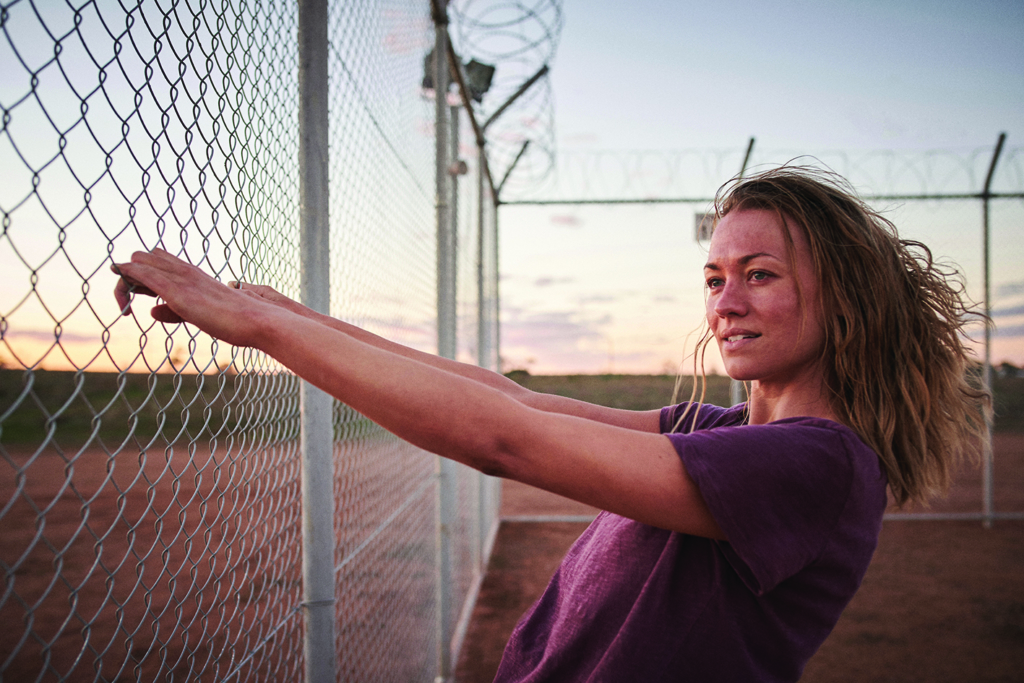
That’s exemplified by the introduction of Asher Keddie in Stateless’ second episode. Playing politically minded bureaucrat Clare, she’s introduced into the thick of things to solve the PR problems facing the central detention facility – like the pair of Tamil refugees perpetually protesting on the roof. The incorporation of a character like Clare into the narrative makes sense: she allows the series to interrogate the politics driving immigration policy; while, from a storytelling perspective, her bird’s-eye view of proceedings helps clarify plot particulars for the audience.
Over the course of the five episodes she features in, Clare is given the kind of robust character arc that earns you an AACTA Award nomination[14]Not a win, though; that honour went to Strahovski, competing for the award for Best Lead Actress in a Television Drama. – she’s imperious and officious, oblivious and proficient, heart-rending and heart-warming all at once. She weeps at the plight she strands her refugee wards in, then coldly defends government policy to the media throngs minutes later. In short, she’s granted the kind of internal depth denied the majority of Stateless’ refugee characters, filling the void left by Sofie’s steady marginalisation at the expense of characters of colour.
Clare’s portrayal is presumably intended to reinforce the heartlessness of the institutionalisation of Australia’s immigration policy. She’s not a monster; she’s ambitious, sure, but her political machinations are driven by efficiency rather than cruelty, and always underpinned by an emotional connection. But none of this matters – the end result is suffering, rejection and isolation. The worthy intentions behind this depiction, though, are squandered by the show’s ill-considered fascination with the primacy of white feelings.
Clare becomes the Caucasian conduit through which refugees’ feelings are filtered. When Kurdish refugee Rosna (Helana Sawires) recounts the pain of her disconnection from her culture, the camera lingers on Keddie’s eyes welling up. Ameer’s tragic decision to disown his daughter to ensure she can safely receive a visa is similarly given weight through the white lead actress’s tears. Rather than constructing a Trojan horse, the centring of Clare elucidates the creators’ inability to truly imagine the plight of a refugee. The latter’s suffering, it seems, is only important in how it makes ‘us’ feel sad.
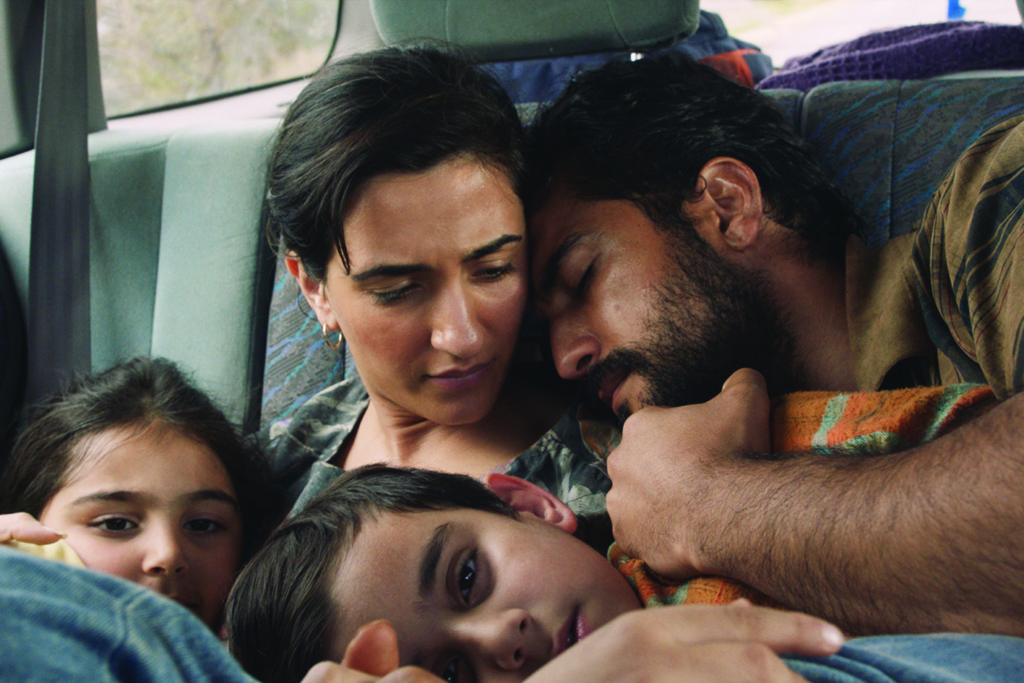
Such flaws are compounded by odd casting and writing decisions throughout. I haven’t really touched upon Cam’s storyline yet, and that’s because there’s not really much to say about it. If you’ve seen any drama in which a moral character is dragged into an immoral institution – in the process, warping his own values and tainting his relationship with his family – then you know what to expect. Courtney is convincing as an everyday Aussie bloke, but his storyline is just as unremarkable.
Well, except for one detail. Rather than surround Courtney’s character with the usual suspects – grizzled fiftysomething beer-guzzling security guard types (though there are a couple of those) – Stateless makes a point of casting (respectively) Indigenous and Pacific islander actors as his two most prominent colleagues. There’s his moustachioed mate Sully, played by Clarence Ryan – an Aboriginal Australian actor – who’s fairly inconsequential to the plot; but, more egregiously, the role of the token sadistic guard is taken by Rachel House, an actress of Maori descent.
Like so many of Stateless’ missteps, no ill intent can be assumed here. Perhaps House’s casting was an attempt to remind us that dehumanising organisations can turn anyone – regardless of their cultural background – into an agent of abuse. And House is unquestionably excellent, expertly embodying the cruel neglect that her role demands. But in the context of a series that relegates its characters of colour to second fiddle more often than not, it feels like an oversight – an attempt to erase the full-throated history of white supremacy that underpins Australia’s immigration policy to this day. Making the show’s face of cruelty a Maori woman feels clumsy rather than bold.
On the subject of clumsiness, I’ll conclude my litany of complaints about Stateless by singling out one scene that summarises my disappointment with the show. The third episode of the miniseries, ‘The Right Thing’, features a flashback in which Sofie attempts to regain favour with Pat (Blanchett), the arch matriarch of a suburban cult. She’s rejected for her ‘negative energy’, with Blanchett sneering, ‘I’m not going to let you destroy our way of life. You need to go home!’ then declaring, ‘You’re not welcome here!’
This sequence is a glaring moment, a fumbled attempt at substantive commentary. This is the insight offered by Stateless into Australian immigration: no attempt to examine the financial selfishness, nor the thick veins of racism, driving our policies; no, Australia is a cult. There’s some truth to that, but no depth. And that’s Stateless, really: a well-intended, well-acted, well-directed attempt to stab at the heart of Australian culture that can only manage to flail around ineffectually with a plastic butterknife.
Endnotes
| 1 | Elise McCredie, quoted in Dee Jefferson, ‘Stateless Sweeps AACTA Awards for TV, While Babyteeth Dominates Film Categories’, ABC News, updated 1 December 2020, <https://www.abc.net.au/news/2020-11-30/babyteeth-wins-best-film-and-many-other-aacta-awards/12934018>, accessed 17 February 2021. |
|---|---|
| 2 | Though produced in Australia by the ABC, launching on 1 March 2020, the series later debuted on Netflix in the United States on 8 July that year. |
| 3 | Meredith Blake, ‘A New Netflix Show About Australia’s Refugee Crisis Has a White Heroine. We Asked Why’, Los Angeles Times, 8 July 2020, <https://www.latimes.com/entertainment-arts/tv/story/2020-07-08/stateless-cate-blanchett-human-drama-not-agitprop>, accessed 17 February 2021. |
| 4 | Maria Fontoura, ‘Stateless: Detention Camp Drama Floats Adrift’, Rolling Stone, 13 July 2020, <https://www.rollingstone.com/tv/tv-reviews/stateless-netflix-review-1025670/>, accessed 17 February 2021. |
| 5 | McCredie, quoted in Jefferson, op. cit. |
| 6 | ibid. |
| 7 | Fayssal Bazzi, quoted in Jefferson, ibid. |
| 8 | See Daniel Keane, ‘Cornelia Rau, Australia’s Immigration Wars and the True Story Behind TV Drama Stateless’, ABC News,1 March 2020, <https://www.abc.net.au/news/2020-03-01/cornelia-rau-and-the-story-behind-stateless/12001280>, accessed 17 February 2021. |
| 9 | Yvonne Strahovski, quoted in Perri Nemiroff, ‘Yvonne Strahovski Addresses the Predominately [sic] White Main Ensemble in Stateless’, Collider, 28 July 2020, <https://collider.com/yvonne-strahovski-interview-stateless-chuck/>, accessed 17 February 2021. |
| 10 | ‘New ABC and Netflix Series Stateless Is a Show About Refugees, So Why Is the Cast So White?’, ABC News, updated 11 March 2020, <https://www.abc.net.au/news/2020-02-28/iview-stateless-detention-cate-blanchett-yvonne-strahovski/12005918>, accessed 17 February 2021. |
| 11 | George Newhouse, quoted in Keane, op. cit. |
| 12 | See Robert Manne, ‘The Unknown Story of Cornelia Rau’, The Monthly, September 2005, <https://www.themonthly.com.au/monthly-essays-robert-manne-unknown-story-cornelia-rau-often-she-cried-sometimes-she-screamed-she-be#>, accessed 17 February 2021. |
| 13 | A frankly baffling choice; the series frequently cuts away from the detention centre to brief scenes of Sofie’s sister, Margot (Marta Dusseldorp), struggling to fight her way through the labyrinthine bureaucracy that prevents her from locating Sofie, only to deny any sense of catharsis. Arguably the most interesting part of Sofie’s – and Rau’s – plight is the fallout, which is left unaddressed in any substantial fashion here. |
| 14 | Not a win, though; that honour went to Strahovski, competing for the award for Best Lead Actress in a Television Drama. |
